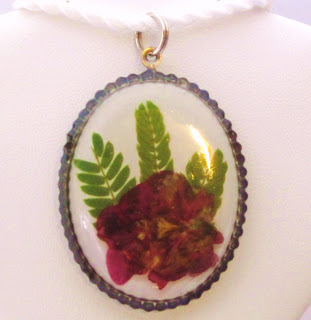In the World Wide Pressed Flower Guild forum coasters have been discussed a lot recently. I would like to introduce an artist I met on Etsy, who makes wonderful pressed flower coasters. Meet Skerry:
I am a Portland, Oregon artist who primarily creates paintings, mixed-media collages and coasters. I use recycled materials whenever possible, often visiting local salvage shops for ceramic tiles, wood and other one- of- a- kind materials. Botanical imagery is a reoccurring theme in my work, as well as vintage book pages, fabric, lace, catalog scraps, and other found vintage materials.
I make coasters out of recycled ceramic kitchen tiles. I have been using Envirotex Lite two- part pour on resin for probably about three years. I switched to resin because I really wanted to find something durable that would protect the art underneath, and as coasters are functional, something easy to clean.
I often create prints of my original paintings and collages, or glue original paper collages down onto these tiles. I also have done a bit of experimenting with pressing flowers and other plant matter into my designs. I like to collect flowers, branches and bark on neighborhood walks and from my own garden. I press petals into heavy encyclopedias, and come back to them after a few days (if i remember!)
Some petals turn brown, don't press well, completely change colors or lose the look I was going for. Some times they come out too see-through, so I have to think about what background will make them show up in the final product. The pressing part alone can sort of be trial and error, but that seems to be what art-making is all about so I try to just go with it : )
I glue the plant matter directly onto the tiles using a polymer medium. I tape all the edges of my coasters with a removable tape. This prevents drips from becoming permanent on the tile. I pour the resin out of a cup, starting in the center, and use a foam brush to bring it over the edges. I don't worry about dripping over the edges, because the tape is protecting the edges and bottom. After the resin dries, I inspect each piece. Some have bubbles that pop at the surface, and that need another coat. Some of the bumpy materials, like bark, also need another coat or two, just to be completely contained and create a flat surface.
set of four zinnia petal coasterscloseup of pressed bougainvillea petal coaster, pre-resin
pressed bark and botanic print coasters set of four.
Bark was collected from the artist's yard, and prints
were found in an old encyclopedia. (note: blue tape is
removed after tiles have been resined...) Because the bark
is extra bumpy, sometimes at least 2 or 3 layers of resin
is needed
 |
| bougainvillea pressed flower coaster, pre resin |
 |
| bougainvillea with bark from the artist's yard |
Problems With Resin.
Bubbles-- With the envirotex-lite, I still haven't found a fool-proof way to prevent bubbles. I usually blow out the bubbles that rise to the top after about five minutes of pouring. In the next hour or two if I am around, I check back and blow out more. I have heard of people using a propane flame to take care of the bubbles, but I haven't tried that yet. The big bummer is when the resin has set and there is a circular bubble popping at the surface. Not much you can do at that point but try to flatten it and re-coat.
Stickiness-- Occasionally, I will come across resined coasters that don't set. Either they are sticky all over, or have small areas that remain sticky. This has an uncanny way of happening a day or so before I have a big show. I have found that if they are not mostly tacky after a day, they will never dry! So I will add another coat, and that does the trick. I believe this occurs if I don't get the proportions perfectly, and I have also heard that humidity can effects the setting process.
Changes colors--Sometimes resin will cause color in plants to bleed, or change the color of the petals. I had some bright bougainvillea petals completely bleed out pink around the petal edges, but I actually liked it-- one of those happy accidents I suppose!
Heat Sensitive-- Sometimes resin is harder to work with when it is in a cold environment. Living in the Portland area, and working in the basement means the resin can get cold. If you put the resin and hardener (the whole containers) into a bath of warm water for about 5-7 minutes, it makes the resin more fluid and and puts it in the best workable condition.
 |
| mixed media collage with pressed flowers |












































